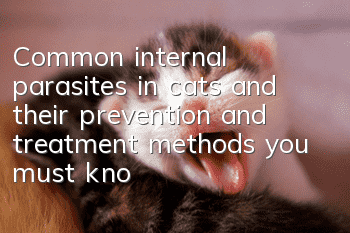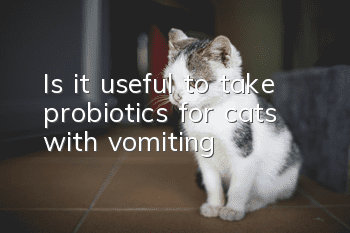Common internal parasites in cats and their prevention and treatment methods, you must know about them as a cat owner

Common internal parasites in cats: tapeworm
Cats with fleas generally have tapeworms on their bodies. If you carefully observe the feces of a cat with tapeworm disease, you can see that there are yellowish-white tapeworm flakes that are about the size of sesame seeds. In severe cases, there will also be flakes around the anus of the infected cat. Tapeworm flakes. Tapeworms usually live in the intestines of cats, causing them to suffer from malnutrition, weight loss, and even pernicious anemia.
Common internal parasites in cats 2: roundworms
Roundworms are a zoonotic disease. Cats suffering from ascariasis will suffer from symptoms such as weight loss, growth retardation, increased abdominal circumference, vomiting, etc. In severe cases, they may even suffer from intestinal obstruction, intestinal perforation, pneumonia, etc., which will endanger their health. Cat's life.
Three common internal parasites in cats: hookworm
Hookworms generally live in the duodenum of cats and can be transmitted from mother to child. A sick mother cat can transmit it to her kittens. Affected cats will have symptoms such as white conjunctiva, weight loss, gastrointestinal disorders, bloody stools, tarry stools, dermatitis, etc. Acute hookworm disease can cause severe anemia and death in cats.
Nematodes: Nematodes parasitize in the bronchioles and alveoli of cats, so the clinical symptoms are respiratory tract infections. Weak kittens are prone to secondary infections that lead to pneumonia; when moderately infected, cats will have symptoms such as coughing and shortness of breath. When cats are severely infected, they will lose weight, have diarrhea, have difficulty breathing and have an elevated body temperature, which can easily lead to death.
Common parasites in cats: heartworm
Heartworm is a parasitic disease transmitted through mosquito bites. Cats infected with heartworm may have no clinical symptoms, only weight loss, loss of appetite, vomiting, and may also cough and have difficulty breathing. However, heartworm infection Infected cats usually die naturally within 2 years. When heartworms travel to the cat's brain, spinal cord or subcutaneous tissue, it is very easy to cause sudden death. The anthelmintic drug DaCaoAi is very effective in treating heartworms. If you suspect that your cat is infected with heartworms, DaCaoAi can be used.
Prevention and treatment methods for internal parasites in cats
1. The oocysts excreted by the parasites along with cat feces will complete sporulation in several days under suitable conditions. When a cat ingests sporulated oocysts and cysts in the muscles, internal organs and other tissues of infected animals, sporozoites, bradyzoites and tachyzoites invade the villus epithelial cells of the cat's small intestine and undergo coccidial phase development. , and finally produce oocysts, which are excreted in the feces. Cats are also intermediate hosts. The spores, bradyzoites and tachyzoites can enter the human lymph and blood just like they parasitize in other intermediate hosts, spread to the tissues of various organs throughout the body, and invade nucleated cells for arching. The insect phase develops and is preserved in the body. In addition, cats can also pass through the placenta, respiratory tract, and skin wounds.Waiting for infection with toxoplasmosis
2. Sulfa drugs and ethylmethamine-sulfadiazine are often used for treatment, 10 mg per kilogram of body weight, orally administered pyrimethamine 4 to 6 times a day, 0.5 to 1.0 mg per kilogram of body weight, orally administered once a day. The above two drugs are more effective when combined. In order to prevent side effects of the drug, tetrahydrofolate phthalate can be taken at the same time, 1 mg per kilogram of body weight per day.
3. Pay attention to environmental hygiene at ordinary times, keep the environment clean and dry, dispose of feces in a timely manner, prohibit feeding raw meat, milk, and eggs, and perform regular fecal examinations.
Tapeworms: Cats with fleas usually have tapeworms on their bodies. If you carefully observe the feces of a cat with tapeworm disease, you can see that there are yellowish-white tapeworm flakes that are about the size of sesame seeds. In severe cases, the cat's anus is also covered with tapeworms. There will be tapeworm flakes. Tapeworms usually live in the intestines of cats, causing them to suffer from malnutrition, weight loss, and even pernicious anemia.
Roundworms: Roundworms are a zoonotic disease. If a cat suffers from ascariasis, it will appear symptoms such as weight loss, growth retardation, increased abdominal circumference, vomiting, etc. In severe cases, it may even cause intestinal obstruction, intestinal perforation, pneumonia, etc. Endangering the cat's life.
Hookworms: Hookworms generally live in the duodenum of cats and can be transmitted from mother to child. A sick mother cat can transmit it to her kittens. Affected cats will have symptoms such as white conjunctiva, weight loss, gastrointestinal disorders, bloody stools, tarry stools, dermatitis, etc. Acute hookworm disease can cause severe anemia and death in cats.
Nematodes: Nematodes parasitize in the bronchioles and alveoli of cats, so the clinical symptoms are respiratory tract infections. Weak kittens are prone to secondary infections that lead to pneumonia; when moderately infected, cats will have symptoms such as coughing and shortness of breath. When cats are severely infected, they will lose weight, have diarrhea, have difficulty breathing and have an elevated body temperature, which can easily lead to death.
- Which is better, a male cat or a female cat? Is it better, a male cat or a female cat?
- How to take care of a cat after giving birth?
- The world's largest cat
- Teach you two tricks to make your cat obedient and have an obedient cat!
- When can kittens be dewormed?
- What should a novice cat owner do if his cat is injured?
- Brown discharge from cat's eyes
- How to get rid of your cat’s bad habits?
- What are the precautions when using deworming medicine for cats? Have you got these points?
- Russian Blue Cat Feeding Precautions



